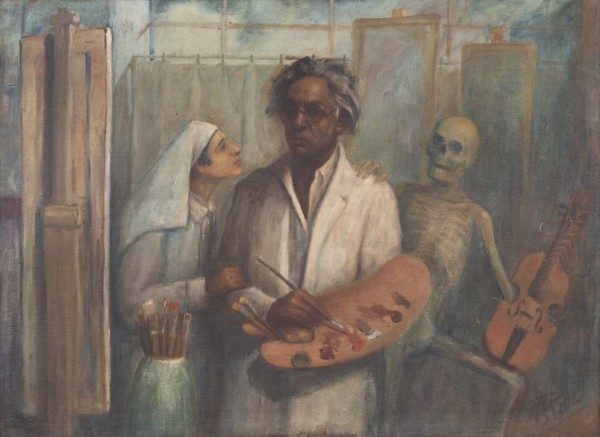A master painter and a sculptor, Antonio Piedade da Cruz is a source of pride to many Goans who know him. He was born on August 22, 1895 in the village of Velim (Salcete, Goa). In 1916, the artist admitted himself into Sir Jamsetjee Jeejebhoy School of Art in Bombay (now Mumbai). From here on, Antonio Piedade da Cruz would go on to be one of the most admired artist of India. He was professionally known as ‘Cruzo’. The artist visited Goa in the 60’s. Here he sculpted the two busts of Menezes Braganza, which are displayed at the Margao municipal garden and the second one at the Panjim municipal garden.
Education
His talents were noticed early on when as a young boy he painted the portrait of the then Portuguese Governor (of Goa) Dr Coceiro da Costa. At JJ School of Arts he was studying under Gladstone Salomon (Principal), M. V. Dhurandhar (salon artist and painter of mythological and historical subjects).
After graduating in 1920, Antonio Piedade da Cruz won a scholarship to study at the Berlin University of the Arts. Here he was given the title of “Meisterschüler” (Master Student). In Berlin he studied under Arthur Kampf, Ferdinand Spiegel and Paul Plontke. He lived in Germany in the 1920’s.
First solo exhibition
Portuguese Ambassador in Berlin noticed Antonio Piedade da Cruz after his name appeared in a German newspaper. He would later hold his first solo exhibition in Lisbon in October of 1925 with the support from the same Ambassador.
Return to India
Circumstances did not stay the same for Cruzo in Portugal. He was blacklisted when Salazar came to power in the country. Cruzo returned to Bombay (now Mumbai) on the advice of Maharaja of Travancore, whom he met in Europe.
Rise in popularity
Cruzo became one of the most popular artist in the country. He set up his studio in the Brabourne Stadium, aptly naming it “Cruzo Studio”. His studio also served as the meeting place for members of the Goa Liberation Movement.
Notable patrons of the artist:
- Maharaja Hari Singh of Kashmir
- Maharaja of Travancore
- Maharaja of Gwalior
- Maharaja of Bikaner
- Lord Brabourne (Governor of Bombay)
- Field Marshal Sir Philip Chetwode (Commander-in-Chief of India)
- Sir Cowasji Jehangir and Lady Jehangir
- Sir Hormusji Dinshaw Adenwalla (philanthropist )
- Sir Chintaman Deshmukh (Governor of the Reserve Bank of India)
- The Birla family
- Purshottamdas Thakurdas
- Vithalbhai Desai
- Bhulabhai Desai (brother of Vallabhbhai Patel)
- Lord Mountbatten (last Viceroy of British India)
Mind of Cruzo
Cruzo’s work mainly centered around poverty and social injustice even though he very often worked for individuals in the opposite situation. His meeting with Mahatma Gandhi changed the theme of his paintings to political with Indian Freedom Struggle as the subject.
Exhibition in Goa
Currently an exhibition is being held at the Sunaparanta Goa Centre for the Arts. The exhibition displays 16 paintings by the artist and 21 archival photographs giving a glimpse into the artist’s life. ‘Quest for Cruzo’ has been curated by Ranjit Hoskote.
“I first heard of Cruzo in conversations with older artists and critics who had been immersed in the Bombay art world of the 1950s and 1960s. As a student, I would often walk past the Cruzo Studio near Churchgate in Bombay. As a child in Margao in the early 1970s, I would have seen the bust of Menezes Braganza in the Margao municipal garden, but I did not then know that da Cruz had sculpted it. I began to join these dots only after seeing his paintings for the first time in 2013, in the studio of the conservator Kayan Marshall Pandole. After the Cruzo Studio had been wound up, these paintings had been left lying in unsuitable storage, and had been exposed to dust, damp, pigeon droppings, and Bombay’s chemical-laden air. They were rescued by Dattaraj Salgaocar, who felt that they should be brought back to their creator’s homeland—Goa. Lovingly restored by Kayan, they now reveal their original colours and brushwork, and are like jewels. Given my ongoing research interest in the artists and writers of the Goan diaspora, I was moved by the works and gradually grew ever more excited by the artist, the multiple contexts he inhabited, and the sensibility that shines out through these paintings.” Said Ranjit in a report.
Antonio Piedade da Cruz was an artist par excellence. The exhibition is a good opportunity for Goans to witness the greatness of this Goan.


